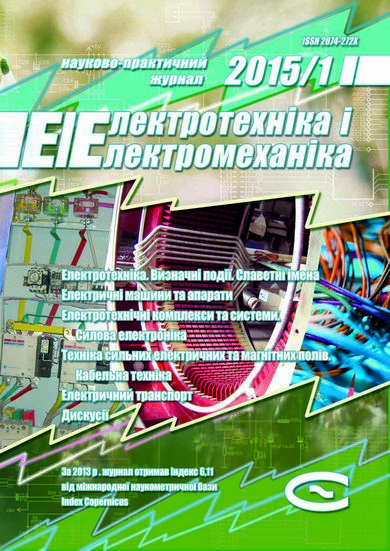OBJECTIVE FUNCTIONS OF THE COMPARATIVE ANALYSIS OF THE ENERGY EFFICIENCY OF ELECTROMAGNETIC SYSTEMS OF INDUCTION MOTORS WITH INNER AND OUTER ROTORS
DOI:
https://doi.org/10.20998/2074-272X.2015.1.08Keywords:
losses indication, optimum geometric dimensions, inner and outer rotorsAbstract
The analytical expressions of determining the optimum geometric dimensions by criteria of the basic losses minimum of the structural variants of the electromagnetic system of the induction squirrel-cage motor with inner and outer rotors based on the method of the relative indications of the technical level with relative controlled variables are obtained and the comparative analysis of the losses indications is carried out.References
Ivanov-Smolenskii A.V., Kopylov I.P., Lopukhina E.M. Prospects of the electromechanics development in the XXI century. Elektropanorama – Electropanorama, 2001, no.1, pp. 14-15. (Rus).
Glovatskii A.V., Kubarev L.P., Makarov L.N. Main directions of the development of electrical machines and electromechanical systems based on them. Elektrotehnika – Electrical Engineering, 2008, no.4, pp. 2-8. (Rus).
Muravleva O.O. Conception and ways of designing energy efficient induction motors. Electrichestvo – Electricity, 2007, no.6, pp. 50-52. (Rus).
Konokhov N.N. Choice of the main dimensions and geometry of active parts of electric machines under different conceptions of their design development. Elektrotekhnіka і elektromekhanіka – Electrical engineering & electromechanics, 2010, no.1, pp.20-23. (Rus).
Petrushin V.S. Energy-efficient induction motors designing with application of a modified criterion of reduced costs. Elektrotekhnіka і elektromekhanіka – Electrical engineering & electromechanics, 2014, no.1, pp. 31-33. (Rus).
Stavinskii A.A. Problem and the directions of electromechanical devices further evolution. Elektrotekhnіka і elektromekhanіka – Electrical engineering & electromechanics, 2004, no.1, pp. 57-61. (Rus).
Stavinskii A.A., Shevchenko V.V., Chekunov V.K. Ways of improvement of the ship's electro-mechanical systems on the basis of innovative technical solutions for electric machines. Vіsnik Natsіonal'nogo unіversitetu korablebuduvannia – Proceedings of the National University of Shipbuilding, 2010, no.2, pp. 287-293. (Rus).
Verbovii A.P., Verbovii P.F., Kravchenko A.M. Highly efficient energy saving induction motors. Elektropanorama – Electropanorama, 2001, no.1, pp. 32-35. (Ukr).
Stavinskii A.A., Palchykov O.O. Application of a relative technical level index method to induction motor optimization problems. Elektrotekhnіka і elektromekhanіka – Electrical engineering & electromechanics, 2014, no.5, pp. 37-44. (Rus).
Rukovodiashchii dokument RD 16538-89. Mashiny elektricheskie maloi moshchnosti. Otsenka urovnia kachestva [Guidance Document RD 16538-89. Electrical machines of small capacity. Estimation of quality level]. Мoscow, VNIIstandartelektro Publ., 1989. 23 p. (Rus).
Palastin L.M. Elektricheskie mashiny avtonomnykh istochnikov [Electrical machines of autonomous sources]. Мoscow, Energiya Publ., 1972. 464 p. (Rus).
Dombrovskii V.V., Zaichik V.M. Asinkhronnye mashiny: teoriia, raschet, elementy proektirovaniia [Asynchronous machines: theory, calculation, design elements]. Leningrad, Energoatomizdat Publ, 1990. 368 p. (Rus).
Downloads
Published
How to Cite
Issue
Section
License
Copyright (c) 2015 O. O. Palchykov, A. A. Stavinskii

This work is licensed under a Creative Commons Attribution-NonCommercial 4.0 International License.
Authors who publish with this journal agree to the following terms:
1. Authors retain copyright and grant the journal right of first publication with the work simultaneously licensed under a Creative Commons Attribution License that allows others to share the work with an acknowledgement of the work's authorship and initial publication in this journal.
2. Authors are able to enter into separate, additional contractual arrangements for the non-exclusive distribution of the journal's published version of the work (e.g., post it to an institutional repository or publish it in a book), with an acknowledgement of its initial publication in this journal.
3. Authors are permitted and encouraged to post their work online (e.g., in institutional repositories or on their website) prior to and during the submission process, as it can lead to productive exchanges, as well as earlier and greater citation of published work.





